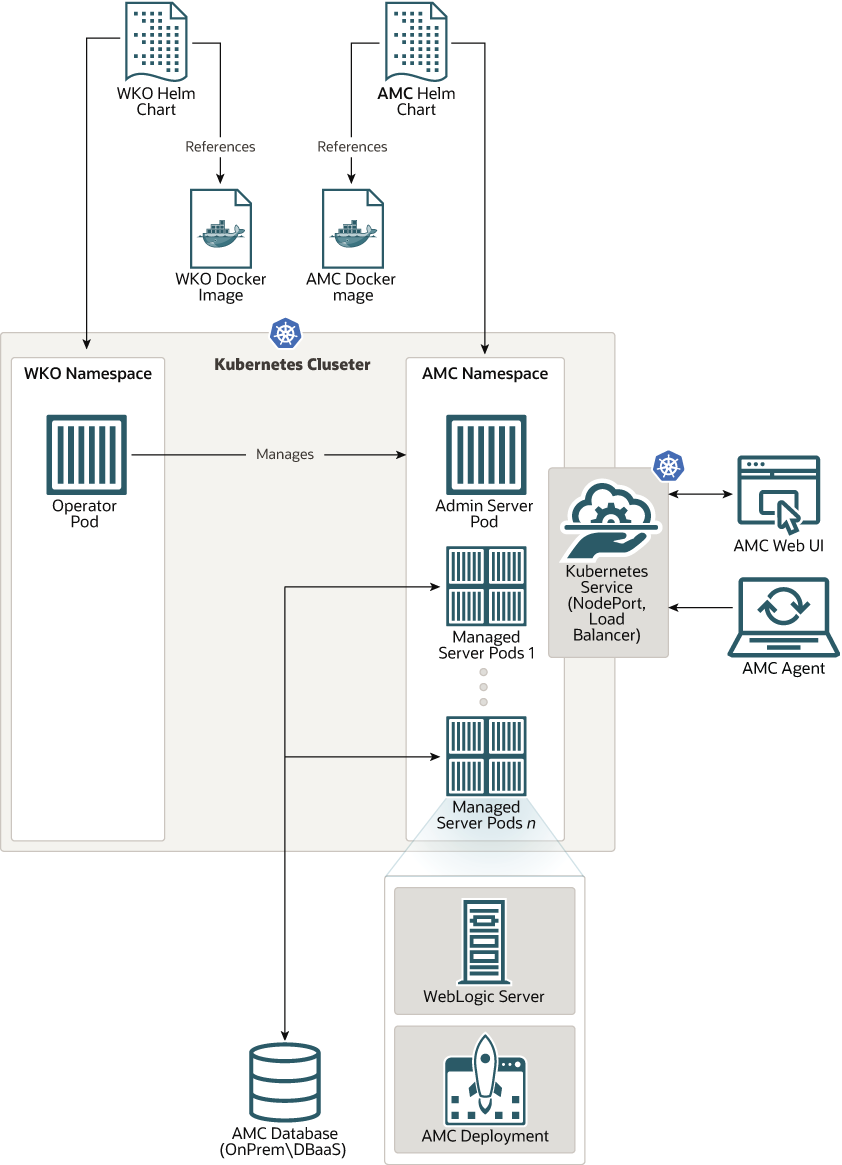1 About Containerized Advanced Management Console
Advanced Management Console (AMC) is a feature available as part of Java SE Subscription. Oracle provides an easy-to-deploy containerized version of AMC.
Unlike a non-containerized AMC, you don’t need to install and maintain the WebLogic Server (WLS) separately. It uses WebLogic Kubernetes Operator (WKO) for deploying or managing AMC. This solution can be easily deployed in cloud or non-cloud environments and leverages scaling functionality of the operator within a Kubernetes framework. This will address the complexity involved in installing and maintaining the non-containerized AMC without the intervention of IT or any specialized technical skills.
The Containerized AMC provides the following capabilities:
- Rely only on well-known and easily available resources to deploy and manage containerized AMC in Kubernetes environment, either on cloud or on premise.
- Reduces installation, configuration, and deployment time.
- Ability to containerize existing compatible versions of the AMC application with underlying WLS component.
- Supports all features provided by non-containerized AMC installation.
- Performance on par with a non-containerized version.
- Easily scale containerized AMC deployments using Kubernetes.
- Ease of migration from non-containerized AMC to containerized AMC without requiring changes or redeploying already-deployed agents; as long as the same address is used for the WLS server or WLS load balancer.
- Supports other external database solutions such as Database as a Service (DBaaS).
- Reduces AMC upgrading overhead.
Overview
The Containerized AMC solution leverages the Oracle WebLogic Kubernetes Operator (WKO) Model in the image pattern for domain creation and management.
See Kubernetes Model in Image.
Architecture Diagram:
Figure 1-1 Containerized AMC Deployment Architecture

As part of this Containerized AMC solution, a custom AMC container image has to be created comprising of an AMC application archive, WebLogic server, and base WDT model that defines the domain home configuration. The Domain resource and other Kubernetes manifests for deploying AMC are packaged and distributed as a Helm chart. This Helm chart points to the container image that is created. The Helm chart values are configurable to support custom deployment settings.
The database installation and configuration for AMC is not included in the containerized AMC. The externally configured database is referenced through data source settings supplied as a part of the chart configuration.
The WKO instance handles the AMC domain creation and management. The installation of WKO is a prerequisite for Containerized AMC and has to be done through the WKO Helm chart, which is hosted on GitHub. After the successful installation of the AMC Helm chart, the admin server and managed server pods hosting the AMC deployment will be up and ready to use.
The Kubernetes service endpoints are exposed either as NodePort or LoadBalancer based on the chart configuration. The AMC Web UI and AMC Agent communicate with the server through these service endpoints.
Advantages
Containerized AMC provides ease of deployment and various advantages as compared to non-containerized AMC.
Some of the advantages of Containerized AMC are:
- It takes approximately 30 minutes to deploy containerized AMC for the first time as opposed to the multi-hour effort to install non-containerized AMC.
- WLS is bundled with Containerized AMC; therefore, you don’t have to install it separately.
- Maintaining Containerized AMC is relatively easy as compared to applying patches manually and regularly upgrading to current versions.
- Scaling flexibility in Containerized AMC removes the complexity of introducing additional components, such as load balancers in non- containerized AMC, which complicates the installation, configuration, and maintenance of WLS and database.
- You can update the images used by the solution with up-to-date versions of WLS and other required components available from Oracle, and other widely available sources, for example, container hub for load balancers.
- Easy to upgrade AMC and WLS versions.
- Leverage WKO features for domain administration and scaling.